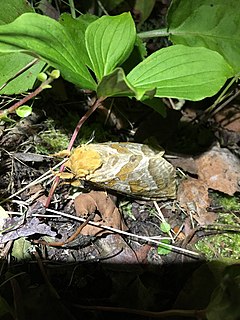
Phymatopus is a genus of moths of the family Hepialidae, which consists of around 500 species and 30 genera. The genus was erected by Hans Daniel Johan Wallengren in 1869. They can be found across Eurasia and North America. Species can be distinguished by the different morphology of male genitalia and different forewing patterns, which vary in stripe colour and size and arrangement of spots. The stripes themselves consist of spots separated by dark veins which are fringed by thin black lines from both inner and outer sides.
Schausiana is a monotypic moth genus of the family Hepialidae described by Pierre Viette in 1950. The only described species is Schausiana trojesa, described by William Schaus in 1901, which is endemic to Mexico.
Cibyra dorita is a species of moth of the family Hepialidae. It was described by William Schaus in 1901 and is known from Brazil.
Cibyra ferruginosa is a species of moth of the family Hepialidae. It was described by Francis Walker in 1856 and is known to live in the northeastern region of Brazil.
Cibyra poltrona is a species of moth of the family Hepialidae. It was described by William Schaus in 1901 and is known from Brazil.
Cibyra tesselloides is a species of moth of the family Hepialidae. It was described by William Schaus in 1901 and is known from Brazil and Paraguay.
Druceiella basirubra is a species of moth of the family Hepialidae. It was described by William Schaus in 1901 and is known from Bolivia and Peru.

Sthenopis purpurascens, the four-spotted ghost moth, is a species of moth of the family Hepialidae. It was described by Packard in 1863. It is found in Canada and the United States, from Labrador and New York north and west to British Columbia and the Northwest Territories, south in the mountains to Arizona.

Dunama is a genus of moths of the family Notodontidae described by William Schaus in 1912.
Langsdorfia coresa is a moth in the family Cossidae. It was described by William Schaus in 1901 and is found in Colombia.
Givira durangona is a moth in the family Cossidae described by William Schaus in 1901. It is found in Mexico (Durango) and the United States, where it has been recorded from Colorado.
Givira watsoni is a moth in the family Cossidae. It was described by William Schaus in 1901 and is found in Brazil.
Hypopta pallidicosta is a moth in the family Cossidae. It was described by William Schaus in 1901 and it is found in Paraná, Brazil.
Givira carisca is a moth in the family Cossidae. It is found in Mexico.
Givira quadra is a moth in the family Cossidae described by William Schaus in 1901. It is found in Costa Rica, Brazil and Paraguay.
Givira pardana is a moth in the family Cossidae. It is found in São Paulo, Brazil.
Givira plagiata is a moth in the family Cossidae. It was described by William Schaus in 1901 and is found in Venezuela.
Givira sabulosa is a moth in the family Cossidae. It was described by William Schaus in 1901 and is found in São Paulo, Brazil.
Costria elegans is a species of moth in the family Cossidae. It was described by William Schaus in 1901 and is found in South America.
Podalia albescens is a moth of the family Megalopygidae. It was described by William Schaus in 1900. It is found in Brazil.


